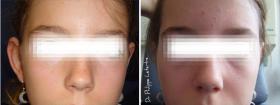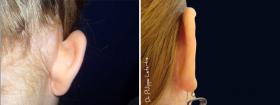Cosmetic ears surgery Otoplasty or protruding ears surgery
What are the motivations for an Otoplasty ?
Malformed or protruding ears are unfortunately prone to teasing and other remarks that may be psychologically hard to bear, bring to school conflicts or become a real complex.
Whatever the age is, the request for surgery should be a personal process. The procedure can be practiced from age 7, when the ear has reached a proper growth.
What are the objectives of cosmetic surgery ?
The intervention aims to permanently correct the anomalies in order to get ears in harmony with your face, symmetrical and natural looking.
Importance of 1st consultation
As with any cosmetic surgery, an Otoplasty involves risks to know, pre-operative examinations to practice and protocols to follow.
During your first consultation, you get a professional answer to all your questions and concerns.
A careful study of the ears and its connections with the rest of the face is made.
A photographic record is made in order for the surgeon to analyze with you the changes to make.
This procedure is most often supported by health insurance.
What happens during the surgery ?
The surgeon first carries out an incision behind the ear.
Then he is going to take off the skin to access the cartilage.
The relief and kinks are then reshaped, according to the anomaly to correct, by acting on the cartilage.
Finally, the incisions are usually sutured with absorbable thread and a dressing is made for you to keep your ears in a good position.
+ What is the type of anesthesia ?
According to the case, anesthesia may be local, deep if administered intravenously by tranquilizers or general.
Local anesthesia is preferred to general anesthesia depending on the age but you will discuss this matter with your surgeon during a consultation.
+ Where is located the incision ?
The incision is made in the postauricular sulcus, that is to say, in the natural crease behind the ear.
The hair is not reached in any way.
+ And the scar ?
Resulting from the incision, the scar is almost invisible because it is hidden behind the ear in natural folds.
+ How long is the surgery ?
The Otoplasty lasts one hour on average.
What are the postoperative courses?
Hospitalization usually lasts a day or takes place on an out-patient basis.
The post-operative pain are generally not significant and relieved by an analgesic and anti-inflammatory if necessary.
A lighter bandage will replace the dressing 2 or 3 days after surgery. It will be held ten days.
Bruising (bruises) and an edema (swelling) appear on the treated area, but gradually disappear.
Disinfection behind the ear is then performed on a daily basis by the patient.
Relatively important sporting activities should be avoided for almost three months.
The patient should protect himself from exposure to heat or cold the first month after surgery.
What is the expected result ?
You must wait 1 to 2 months in order to evaluate the final result.
The intervention is effective on both the psychological and aesthetic points and helps stop the possible mockeries.
+ What are the specific risks of anesthesia? ?
During your obligatory talk with the anesthetist, he will inform you in detail of the risks of anesthesia.
It is useful to know besides that during the last twenty years, the risks have not been eradicated but remain almost insignificant.
+ What are the specific risks of the surgery ?
During the consultations with your surgeon all the possible complications will be detailed to you. Fortunately they are rare.
To inform you in advance, here are the possible risks :
- An hematoma : requiring evacuation.
- An infection : which may require antibiotic treatment.
- An unfavourable evolution of the scars that will require an appropriate treatment.
These informations given by Dr. Philippe Letertre should only be a help or a supplement to your surgeon’s consultations
Our space "Questions / Answers" is also available for you.
Feel free to contact Dr. Letertre
so that he could meet your expectations.



